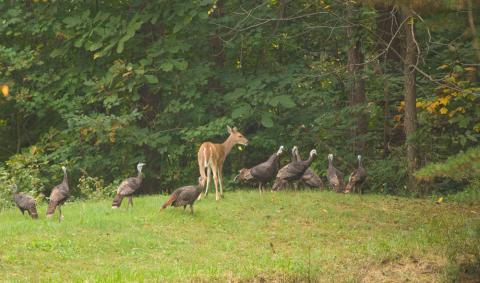Ron Jolly | Originally published in GameKeepers: Farming for Wildlife Magazine. To subscribe, click here.
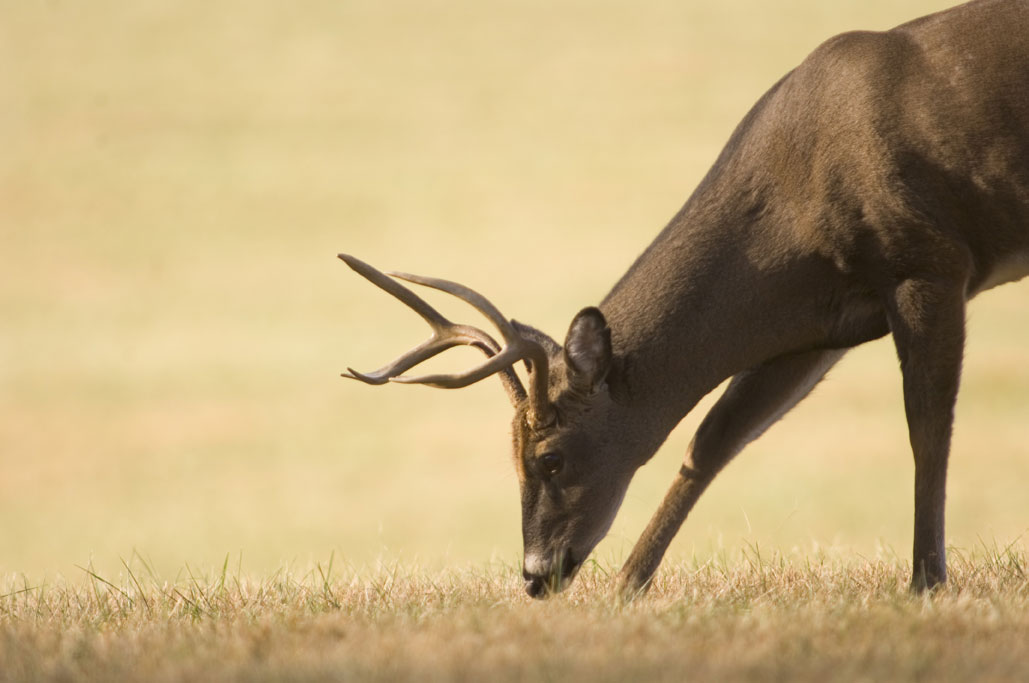
One of the greatest thrills as a gamekeeper is discovering a new buck taking advantage of the bounty on our farm. In today’s world of constant surveillance via trail cameras, these discoveries are not uncommon. They are, however, the fuel that drives our efforts to provide the reward that leads to more discoveries.
In the summer of 2010, we began getting pictures of an interesting new buck on the farm. From the very first picture, it was obvious this was a unique buck. He sported long legs and a sleek body. His wide, seven-point rack appeared unusually large for what my wife Tes and I considered to be a three year old. At the end of that summer, he was officially named “Handle Bars.”
Handle Bars was one of those bucks we call a “tweener.” He was a borderline shooter but looked like he met enough of our requirements to put him on the “hit list.” This dilemma is another bonus for gamekeepers. Critical decisions on body weight, antler mass, beam length, muscle tone, antler spread and rack configuration combine to determine if a whitetail buck makes our hit list. As with most decisions made jointly between a husband and wife, there is sometimes a difference of opinion.
My wife Tes is a veteran deer hunter. She has a unique ability to dissect a situation and make her decision. Countless hours spent photographing whitetails give her an advantage in the process of deciding which bucks are shooters and which are not. From the beginning, she dubbed Handle Bars a shooter. I, on the other hand, was not convinced.
First Encounter
Looking back, I think one reason I was skeptical about Handle Bars was the crop of shooter bucks partaking the bounty of our farm in 2010. In all, there were six bucks on my hit list topped by a buck we called “Little Joe.” Tes’ hit list carried the same bucks plus Handle Bars.
When bow season opened on October 15, 2010, Tes and I were quickly reminded how tough it is to kill a mature buck on a small farm. The sign and trail cameras told us our shooters were still around, but not in daylight hours. Then, on November 8th, Tes caught a break.
She was hunting a trail leading to a standing cornfield when a bachelor group of bucks made their way past her. None of the five were shooters. Then, at last light, Handle Bars appeared on the trail headed her way. When the buck reached her shooting lane he was 25 yards away. The arrow hit Handle Bars with a loud “whack”. He spun and crashed back the way he had come with the Lumenok™ glowing bright green on the end of her arrow.
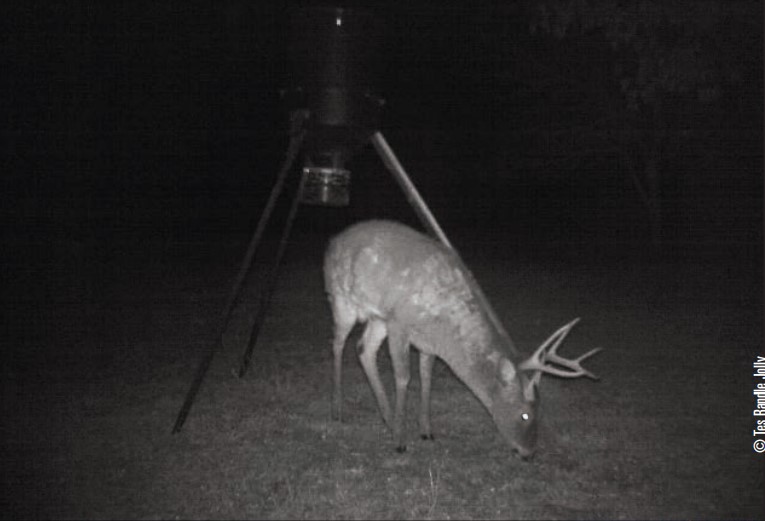
I was just getting home from work when my cell phone beeped alerting me to a text massage from Tes: “Just shot Handle Bars! May have hit a little high but could see the Lumenok glowing as he ran away. Saw him stop, then the arrow fell. Think he is down!” I quickly thumbed: “Don’t push him. Sneak out when you can.”
Twenty minutes later, Tes was gushing with excitement as she told the story: “He just appeared! His head went behind a tree and I was able to draw my bow. He walked right into my shooting lane and stopped when I grunted at him. I put the pin behind his shoulder and let the arrow go. It all happened so quickly! The arrow made a loud whack when it hit. It may be a little high but I think he is right where I last saw the arrow glowing. It just went down. I would have seen it moving if he walked off.”
We waited 30 more minutes before heading back to where she had last seen Handle Bars. Tes led me to where she had last seen the Lumenok™. There, in the tall grass, lay the arrow with the nock glowing brightly. There was no sign of Handle Bars. We carefully searched the area looking for blood before picking up the arrow to examine it. It was apparent the arrow did not penetrate very deep and there was only a small amount of blood on the shaft. There was fat and hair that indicated a high muscle hit.
We spent the next hour combing the area. From where the arrow lay to where Handle Bars was shot we found only a few spots of dark red blood. It was clear that we were dealing with a non-lethal shot. Tes was crushed. The next day she spent hours looking for Handle Bars. The text that came to me at work read: “I have looked everywhere and there is no sign of him. I blew it!” I replied: “We have all done it. Doesn’t make it any easier.”
At the time I had no idea how prophetic that statement would be. One week later, I shot Little Joe only to recover him after the coyotes had stripped that beautiful buck to the bone. We were off to a bad start in 2010.
Second Encounter
After Handle Bar’s encounter with Tes’ arrow, the buck totally disappeared. No sightings, no trail camera photos. Tes worried that he had died from the misplaced shot and we had not found him. I felt certain he had survived but I was dealing with my own demons. Coyotes finding Little Joe before I did was haunting.
December is typically a slow month for deer activity on our farm. The deer have been pressured enough to know it’s “game on,” food is abundant and the rut is not until mid-January at best. We call it the “December doldrums”.
As slow as December is for us, it is an excellent time to inventory bucks using the farm at night. We have learned from experience that mineral licks are nighttime hotspots and a great place for trail cameras. To enhance the effectiveness of our mineral licks we add a Biologic BioRock. This combination becomes a buck magnet. We also maintain one feeder in a 20-acre sanctuary year round. This feeder is another point of focus for our trail cameras.
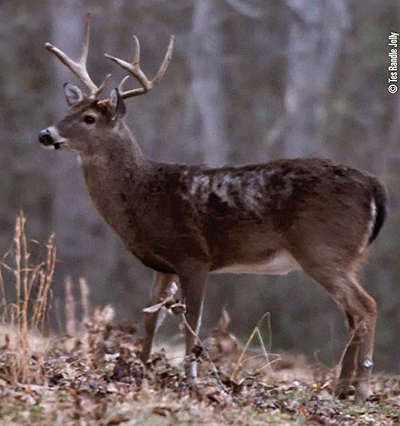
couple photos of Handle Bars and decided to pass the
buck for that year.
I was at work when another text caught my eye. It was from Tes with a photo attached. Under the photo of Handle Bars at one of the mineral licks Tes wrote: “He’s back! So relieved! No sign of the arrow wound but something looks odd about the hair on his side. Any ideas?” My reply was: “No idea what that is. Looks like he is having a bad hair day. At least he is alive and on the farm.”
After that first set of photos of Handle Bars in mid-December, he became more and more regular on the farm. It was always at night but at least he was still around. We never saw him during daylight again until January 25. Tes had decided to hunt a food plot near our east line. As is often the case, she carried her camera. To her surprise, Handle Bars followed a doe into the plot well before last light. Her first reaction was to reach for her rifle, but when she settled the crosshairs on Handle Bars her analytical nature took over.
“I was shocked when he walked into the field with plenty of light left,” said Tes. "This was only the second time we had laid eyes on this buck. My first reaction was to take the shot, but I noticed he was totally enamored with the doe he was following. I felt I had time so I picked up my binoculars for a better look.” Tes continued, “The first thing I noticed were the white blotches on his side. I could see no sign of the arrow wound from November. It only took seconds to trade the “Nikons” and rifle for my camera. I don’t know when I decided not to shoot Handle Bars but somewhere in the process I simply knew he deserved another year.”
That night Tes and I studied the photos she had taken. In my opinion, he was a very good three year old. She finally agreed and was proud of her decision to let him walk that afternoon. He met our width, body weight and beam length standards; however, his mass and seven points were less than we like to see on a shooter buck. We were confident he would be a no-brainer for the next season but the blotchy hair of his sides gave reason for concern.
Third Encounter
Throughout the summer and early fall of 2011, we got photo after photo of Handle Bars. He appeared slick, fat and healthy. His 2011 rack was a mirror image of the previous year but sported more mass. Again, he grew the same seven-point rack. He appeared to have gained at least 20 pounds and there was no sign of the ragged coat from the year before. Then, in November, he disappeared. No trail camera images, no visuals. The 2011-2012 deer season ended leaving us wondering if he had been shot or died from natural causes. Then, during February, trail camera photos caught him back on the farm. As delighted as we were to see he was alive, we were concerned about the condition of his winter coat. He looked ragged and thin.
Like most landowners who practice QDM, Tes and I were excited about the 2012 deer season. Our hit lists contained several bucks that we had watched grow into shooters. Both of our lists featured Handle Bars. His rack was very similar to the year before but now we estimated him to be a five year old. There was no doubt his rack had reached its full potential. The cameras kept telling us he was using the farm at night but we could never lay eyes on him. He had become a typical mature whitetail. He knew the game and how to win it.
As January and the Alabama rut approached our trail cameras revealed Handle Bars on the east side of the farm night after night. Tes and I decided to focus our efforts in that area. On January 12, our nephew Steve arrived for his annual hunt. On his last afternoonI put him in the shooting house on a small food plot we call the Pond Plot. Just before the sun set, Handle Bars followed a doe into the field.
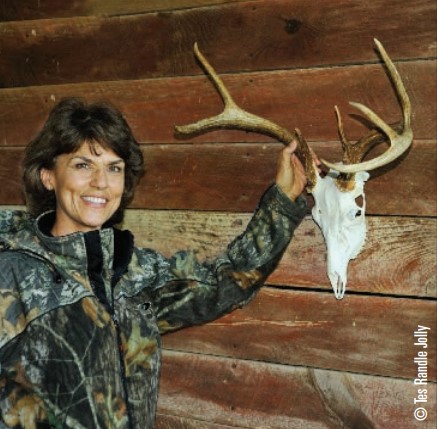
Later his jaw bone would suggest his age was six.
At 4:45, I heard Steve shoot. At 4:47, I opened the text from Steve. It read: “Got him!” I replied: “Got who?” Steve responded: “Handle Bars! He’s down in the field!” I came back with: “On my way! Congrats!” I had no more than reached my HuntVe when I heard two more shots. I raced to see what was going on. When I reached our home Steve was standing in the road leading to the Pond Plot.
His story began “I put the crosshairs behind his shoulder and pulled the trigger. He hit the ground like a sack of potatoes! After I sent the message to you and Tes, I went to put my hands on him. When I got about 40 yards from him it was like he just came to life. He started trying to get up and flopping around in the field. I shot twice more and he lay still just out of the field. I came here to get you guys to help,” said Steve.
By the time Tes, arrived it had been over 30minutes since Steve’s first shot. We drove the cart to the shooting house and let Steve lead us to his buck. He was gone! Where he had first fallen in the field there was hair and a small puddle of blood. Where Steve last saw him was smaller puddle of blood. From there, we found only a few drops of blood before he left our farm and crossed onto the neighbor’s to the east. After hours and hours of searching for Handle Bars over a three-day period we finally decided he was gone… again.
Steve was devastated. The buck was the biggest deer he’d ever had an opportunity to shoot. Tes felt his pain and did her best to support and console her nephew. Once again, we were concerned we’d never learn Handle Bar’s fate. Unbelievably, one week later, trail camera video clips revealed the buck, with seemingly nine lives, was alive and looked normal except for the blotchy hair. Three days later Handle Bars followed a hot doe into a food plot and in front of Tes’ gun. When I heard the fateful shot I sent this message: “You shoot?” Tes: “Just shot Handle Bars. I can’t believe he was on his feet at 4:30 in the afternoon.” I asked: “Is he down?” Tes: “Don’t know. Pretty sure it was a good shot. Shaking too bad to go look. Can you come?” I answered: “On my way!”
Last Encounter
Handle Bars was dead only a few yards from where Tes had last seen him. We could not believe what we saw when we reached him—about half the hair was missing on his sides and behind his ears. The thickened skin was nearly covered in blistery bumps. Six inches behind his ears was a flesh wound from Steve’s bullet. The rack was 19 1/2 inches inside. Handle Bars weighed 190 pounds. Later his jaw bone would suggest his age at six years. Tes and I knelt and said a short prayer of thanks for the wonders we encounter while living the “Gamekeeper life.” We gave thanks for the opportunity to hunt a buck like Handle Bars and the lessons he taught us. When the prayers and hugs ended I made a close-up cell phone picture of the wound on Handle Bar’s neck and sent it in a text to Steve: “You might want to check your scope before you hunt again. Looks like it may be shooting a little high and left!”

















